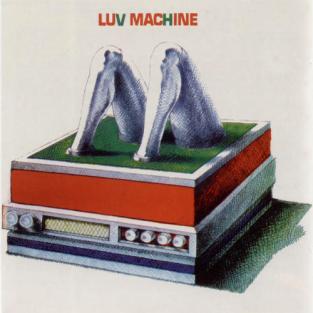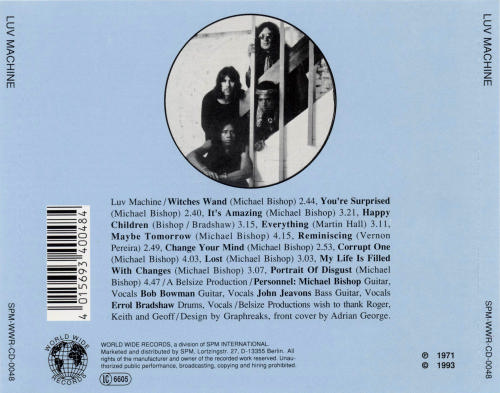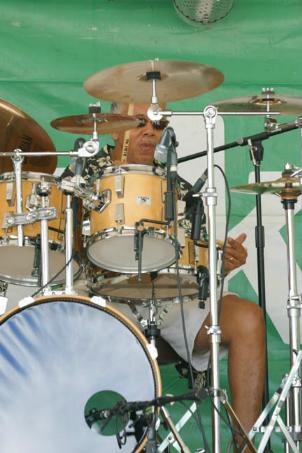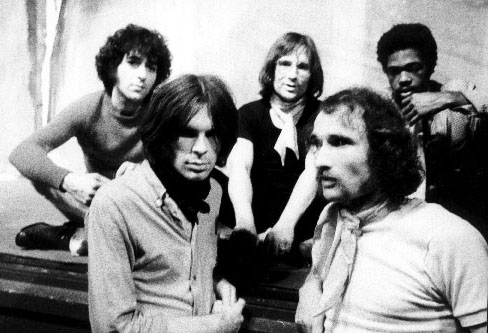Dan Deacon – Spiderman of the Rings
 Artist: Dan Deacon
Artist: Dan Deacon
Album: Spiderman of the Rings
Released: May 8, 2007 | Carpark Records
Recorded: 2007 | Baltimore, MD
Players: Dan Deacon
Track Listing:
- Woody Woodpecker (3:50)
- The Crystal Cat (3:53)
- Wham City (11:45)
- Big Milk (4:25)
- Okie Dokie (2:37)
- Trippy Green Skull (4:01)
- Snake Mistakes (4:11)
- Pink Batman (5:05)
- Jimmy Joe Roche (5:57)
So last post I was struggling to find a modern comparison to Mr. Timman’s live act. Somehow I forgot about my musical hero of 2007. The man I look up to in all facets of musical superdom. The man who makes Girl Talk look and sound like the simpleton trash that he is. A real artist, a real wierdo, Dan Deacon.
I stumbled upon Spiderman of the Rings in the back of a small music store on South Street in my first excursion to Philadelphia. A Pittsburgh native since three years old, I don’t know how I managed to travel Europe, drive across our country at least five times and see both Mexico and Canada before visiting Philadelphia.
I was not ready for any of this. Accompanied by father and sister, who were always eager to receive music recommendations from myself, I popped in the disc as we drove towards St. Joseph’s. Somewhere in the middle of “Woody Woodpecker”, my Dad complained about it not even being music. It was over. That night, I blasted the album on repeat in my hotel. I was convinced Dan Deacon is the future.
The first track, using various speeds of the infamous cartoon woodpecker laugh, Deacon creates a playful, yet suspenseful intro track. The descent into madness begins.
The next, “The Crystal Cat”, the ‘single’ of the album (and I only say that because of the music video made, plus the track is pretty damn catchy, I think even the uninitiated could grasp onto it) is a perfect song to drive to, if you are into driving the opposite direction of traffic on the 405 at dawn.
“Wham City” is the real musical breakthrough on the album. What could have easily been two (or even three) separate tracks, Dan Deacon creates a twelve minute electronic epic tied together by an nonsensical, sing-a-longable, chorale rap in this ode to the Baltimore art collective which he belongs. I must have listened to this track fifty times, and still I get caught thinking another has begun until the chorus kicks in again. This is what music should do, it should take you places you’ve never imagined and drop you back off on your head when you are done.
“Big Milk”, my favorite kind of milk by the way, is a simple instrumental number using midi-bells over a quiet piano loop constrained by clockwork rhythm (It ticks..) and decorated with live synth effects. It’s amazingly inventive and yet surprisingly simple. A great track to add to your personal sleep playlist.
Another perfect track to crash your car too, “Okie Dokie” intersperses Deacon’s mangled verses of childlike thrills between anthemic rock shouts of “I’ve got a rattlesnake gun” and “I’ve got an aerosmith gun” (I think) to hit me where it really counts. I feel you Dan, I got one too. This track could be a collaboration of TV On The Radio, The Modern Lovers and LCD Soundsystem if the musical world were to grant us such gifts. It will not. But Dan Deacon will.
“Trippy Green Skull” is just what it sounds like. It scares the hell out of me everytime. You can judge for yourself.
Then Dan brings it back down to Earth, with “Snake Mistakes”. I make these snake mistakes. Clever vocoder work alongside bass & FX loops with and ode to his dad in the middle. For all the rappers that I see with songs to their mother on their second album, this was a pleasant (if not sarcastic) surprise. On that same note…
“Pink Batman” could easily be the theme song to the homosexual equivalent of the crime-fighting Chiropteric super-hero, or it could sit alongside Mark Mothersbaugh’s work on The Life Aquatic OST. Whatever you are into, Dan Deacon does not discriminate.
A synth arpeggiator begins the final cut, “Jimmy Joe Roche”. A multimedia artist himself, Mr. Roche is credited with filming and editing most of Dan’s videos found around this old interweb. I imagine this is what life sounds like inside a pinball machine. It doesn’t quite sum up the album as much as I would like, however. Hopefully, it is Dan’s way of saying ‘to be continued…’.
Definitely the most well-scripted of all the Dan Deacon releases, Spiderman of the Rings (though I don’t like saying such things) was probably my favorite new album of 2007. As a musician, it inspired me to continue my craft of electro-acoustic madness in ways unprecedented since the release of OK Computer ten years earlier. Musically that is not a fair comparison to either Radiohead or Dan Deacon, but it is made rather to illustrate what each album meant to me. Man still has much to achieve.
<Download older Dan Deacon tracks here>
Album Unity: 7
Longevity: 9
Musicianship: 6
Originality: 10
Production: 7
Johan Timman – Trip Into The Body
Artist: Johan Timman
Album: Trip Into The Body
Released: 1981 | Fleet
Recorded: 1980 | Netherlands
Players: Johan Timman
Track Listing:
- Trip Into The Body (6:30)
- The Brain (5:52)
- The Heart (4:03)
- The Blood (The March Of The White And The Red Corpuscles) (6:22)
- The Blood Cells And The Antibodies (Look Out For The Killer) (5:45)
- The Windpipe (0:43)
- The Lungs (5:12)
- The Hemoglobin (0:42)
- Inside The Tympanic Cavity (1:21)
- Hearing (Ocean Of Sound) (6:57)
There are moments of bliss in life where one thinks he’s got it. There’s nothing left to hope for; it couldn’t get any better than this. And at brief moments throughout this album, Johan Timman duplicates those feelings, but then, much like we humans are apt to do, attempts to stretch it out for longer than necessary, effectively ruining a beautiful thing. Maybe I am being too harsh, I really enjoy this album, and I incessantly bug all my musician friends to watch this video performance of “The Lungs”. Nonetheless, Mr. Timman seems to jerk it a little too hard sometimes. It’s okay, I would too if I could produce this all live. “The Lungs” would be my forty-five minute, adrenaline inspired super-epic.
Nonetheless, Mr. Timman surely recieves an ‘A’ for concept. Stevie Wonder had journeyed through ‘the secret life of plants‘ in 1979, but Johan upped the ante. Let’s write a soundtrack that would accompany a trip through the human body. Simply genius. I must say, however, I’m a sucker for any album claiming to be a soundtrack to anything thats not a major motion picture release. (Someone write me a soundtrack to lawn-mowing.)
“Trip Into The Body” leads things off with a vocoderized ‘human brain’ welcoming you on your voyage. The multi-layered MOOG funk begins almost immediately, yields to a playful chorus, then goes on for about two minutes two long. Again, a common problem when studio albums exclusively feature live solo-instrumentation.
On “The Brain”, the annoyance of synth cymbals is easily forgotten by the heavy orchestration. Several times throughout the album, Timman’s sequence choices remind me of orchestration Jon Brion would come to do in his early years (e.g. Rufus Wainwright’s self-titled album). Timman, much like Brion, does a fantastic job filling the entire spectrum of sound, not just here, but on the whole album. Why doesn’t everybody learn the piano first?
“The Heart”, cleverly or rather predictably (depending on how big of an asshole you’d like to be today) opens with a steady, pounding, rather-human-like (for electronic-percussion) beat. Steadily riding the fine line between campy and classic, the melody is solid, but the tone, perhaps merely a victim of time, runs the verge of being cheesy. Nonetheless, this is one song that doesn’t bore me.
The next two tracks are eerily similar in sound and structure, and each at least a minute too long. They both exude a haunting feel, even when things, musically, go major. Timman’s cleverness precedes him, however, as the riff for the next track, “The Windpipe” is hinted at several times in the second half of “The Blood Cells And The Antibodies”. I’m a sucker for the small things like that within an album.
“The Windpipe” and “The Lungs”, played together, highlight the peak of the album for me. Just watch this video (same as link above, fyi).
Ahh, “The Lungs”. Had I been born fifteen years earlier, something like this would have surely changed my teenage life in 1981. Too bad I was negative two at the time. I was instead stuck with a dead Kurt Cobain and bands that thought it’d be cool to just remove some of the strings from their instruments.
“The Hemoglobin” serves as an effective, yet forgettable track for travelling from the lungs to…
“Inside The Tympanic Cavity” things are simple, yet spooky. Droning synth’s throughout underlie a methodic, question and answer lead line. Unfortunately no definitive answers are given.
I want to like the last track, “Hearing (Ocean of Sound)” more than I do. It reminds me of Kraftwerk’s Computerwelt almost immediately, but is less edgy, less constrained, but harkens to earlier Kraftwerk efforts for its anthemic personality. Does it really need to be seven minutes long though? It’s more of a fishbowl of sound, you can grasp it all rather fast.
All in all, I do need to track down a physical copy of this. It is great, it really is. It is also a bit dated, but when you dedicate an album to one electronic instrument that result is almost unavoidable. Regardless, I feel it is a critical part of music, let alone electronic music, history. Does any one man attempt to do similar things live anymore? Not that I’ve seen.
Album Unity: 9
Longevity: 6
Musicianship: 8
Originality: 9
Production: 7
Total Score: 39
Luv Machine – Luv Machine
 Artist: Luv Machine
Artist: Luv Machine
Album: Luv Machine
Released: 1971 | Polydor
Recorded: 1971? | UK
Players: Michael Bishop (guitar, vocals), Bob Bowman (guitar, vocals), Errol Bradshaw (drums, vocals), John Jeavons (bass, vocals)
Track Listing:
- Witches Wand (2:45)
- You’re Surprised (2:41)
- It’s Amazing (3:21)
- Happy Children (3:07)
- Everything (3:16)
- Maybe Tomorrow (4:19)
- Reminiscing (2:52)
- Change Your Mind (2:57)
- Corrupt One (3:47)
- Lost (3:06)
- My Life Is Filled With Changes (3:05)
- Portrait of Disgust (4:53)
Somehow Luv Machine ended up in limited release in 1971, the band disbanded around the same time, and what could have been a fairly popular and influential psychedelic blues-rock act (as if there wasn’t enough bellowing out of the UK at the time) was all for naught. Information about the band and the album is very limited on the internet, something that surprised me, seeing how Rise Above Relics Records has re-released the album recently, under the title Turns You On, it since been seen periodically on torrent sites netwide.
Luv Machine have drawn comparisons to UK’s own Killing Floor, sounding to me like a bastard child of Jefferson Airplane, Sabbath, and King Crimson. Sources cite both Barbados and New Zealand as the original location of the group, though members most likely hail from both countries, Luv Machine not being fully formed until they met in the UK. This all, of course, is speculation. The record was banned from radio play in Australia and New Zealand, indicating some level of popularity there, because its cover was deemed “pornographic.” Personally, it doesn’t really do much for me.
Luv Machine rips the first two tracks in under five and a half minutes with a psychedelic-blues-punk urgency seldom heard since the Meat Puppets. “Happy Children” could have easily appeared on any post-1973 Zeppelin album. “Maybe Tomorrow” might be my favorite track, if not just for the genius, yet simple ending, leaving one yearning for track six to begin. When it does, one quickly realizes “Reminiscing” is a fantastic, catchy pop-rock tune, which easily could have provided for an more than adequate single. Writing album reviews makes me feel like Patrick Bateman sometimes.
Though the musicianship is nothing spectacular, and choice of keys and sounds could sometimes be questioned, Luv Machine plays extremely well together. Bradshaw holds the listeners attention with his powerful, sharp fills while Jeavons ties everyone together for the majority of the work. Bishop’s vocal varieties, however, are what truly make this album a delight for me. I really need to be returning some videotapes.
As such a rare work, the original Polydor LP is a heavily sought, rarely acquired collectible today. If you are a fan of the psychedelic or British blues-rock era, this album is a must listen. And despite how some songs may sound on the surface, Luv Machine in 1971 must have been very punk. I feel its punk, hardcore. Why else would it get banned from radio play?
Luv Machine Rear Cover, 1993 release 
Errol Bradshaw runs the house band at the Waterfront Cafe in Bridgetown, Barbados. Here he is pictured at Weiser’s Beach Bar.

Album Unity: 7
Longevity: 7
Musicianship: 7
Originality: 7
Production: 6
Total Score: 34
Monster Movie – Can
 Artist: “The” Can
Artist: “The” Can
Album: Monster Movie
Released: 1969 | Mute
Recorded: 1968-1969 | Bodenstein Castle, Köln, Germany
Players: Holger Czukay (bass guitar, sound engineer, electronics), Michael Karoli (guitar, violin), Jaki Liebezeit (drums), Malcolm Mooney (vocals), Irmin Schmidt (keyboards, vocals)
Track Listing:
- Father Cannot Yell (7:01)
- Mary, Mary So Contrary (6:16)
- Outside My Door (4:11)
- You Doo Right (20:20)
Can’s debut album, Monster Movie, opens with the sounds of a Lou Reed-style side-project exploring punk and electronic music. The high highs and dissonant, feedback-laden guitar quickly bring to mind Cloud Taste Metallic-era Lips. As the drum and bass take things for an intense, slightly loopy twist, Mooney (half of the inspiration for the name of modern quintet, The Mooney Suzuki, Mooney’s replacement Damo Suzuki being, of course, the other) begins a Morrison-esque poetry/chanting session. “Father Cannot Yell” ends with nothing short of punching, pounding and squealing ecstasy.
Again sounding a bit like the Velvet Underground in steady, jangle-rock production, Can uses a common, traditional nursery rhyme for inspiration on “Mary, Mary So Contrary.” Karoli’s violin and Mooney’s emotion and spontaneity hold things together for an otherwise fairly straightforward piece, actually slightly reminiscent of “Heroin” towards the end.
“Outside My Door” really rocks my ass off for four straight minutes. It reminds me of some sort of pre-punk southern rock symphony written by a bunch of European lads. Though the chorus recalls Manzarek and The Doors, listening to “Outside My Door” is like seeing fossils of the ancestors of all garage, punk and progressive bands since the late sixties.
The final track checks in at just over twenty minutes, allegedly cut from a jam session originally running between six and twelve hours long (depending whom you ask), mixed and mastered by bassist Holger Czukay. A playful and uplifting track, “You Doo Right” highlights the repertoire of player Jaki Liebezet better than the previous three. What seems to be a heartfelt, lyrical celebration of love, Malcolm Mooney’s yelping draws comparisons to early Gordon Gano at times. Any one song that can seem to combine this with Mogwai-like progressive qualities and flicks and splatters of Pearl Jam’s No Code, all while being very entrenched in the roots of African tribal music, should be respected for the important part in musical history that it is.
“You Doo Right” did in fact stir up the new sound, the future of Can, heard on the following albums, Tago Mago and Ege Bamyasi. The only drawback I have with Monster Movie is the lacking production at some key moments. As far as debut’s are concerned, however, this one is as ground-breaking as any other rock group’s from this era.
Can, 1968

Jaki Liebezeit, Michael Karoli, Irmin Schmidt, Holger Czukay, Malcolm Mooney
Can, 1989

Holger Czukay, Michael Karoli, Irmin Schmidt, Malcolm Mooney, Jaki Liebezeit
Can, “Vernal Equinox” on the BBC, 1975
Brian Eno’s Tribute to Can
Album Unity: 7
Longevity: 9
Musicianship: 7
Originality: 10
Production: 5
Total Score: 38


